danbricklin.com/speeches/wlforum2000
|
|
|
|
Draft #1a (11 pm 3-Sep)
|
Thanks, Jim!
As both an inventor and an entrepreneur, I think it is important to have an understanding of what makes the Internet a fertile bed for innovation, where even lone individuals can make contributions that effect the whole world. Big companies and governments may think they understand what's going on, but in reality things have changed and they have much less control than they used to. And, what we see today does not necessarily tell you what you'll see tomorrow, it's just a hint of it.
In my talk, I'm using hand drawn stick figures to show you how you could explain what I've said to othrs over dinner by drawing on a napkin.
First, let's look at the evolution of communications.
In the old, pre-digital days, implementing a "communications application", like television, the telephone, or two-way radio, required all links in the chain from one end to another to be built and tuned specifically for that application.
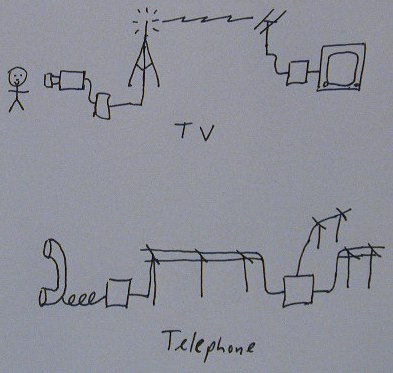 For example, in the U.S., the TV cameras, radio spectrum allocations, antennas, receivers, and more were all designed together knowing that it was a TV signal. The scarcity of places for telephone poles, radio spectrum, and the high capital costs to build the entire chain for each application led to natural monopolies and government regulation as well as to slow innovation. Individuals with ideas but without great financial backing need not apply.
Then, along came digitization. Sound, pictures, words, measurements, most anything could be converted to ones and zeros.
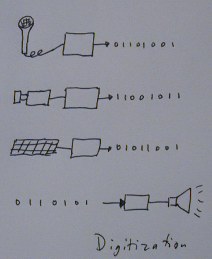 With the right connection devices, digital data could be carried by radio, wires, light, even smoke signals.
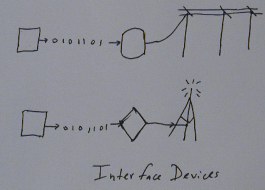 If you converted what you wanted to communicate to digital and then used a connection device, you could piggyback on an existing infrastructure or share a new one for many applications. The turning point in the U.S. was when the government decided to force the telephone monopoly to allow direct connection to their telephone system. That gave us fax and dialup computing like Lexis/Nexis, CompuServe, on-line banking and more.
Going digital meant the cost to deploy a new application was lower because you didn't need to build an entire chain from one end to the other. You just converted into digital form and built connection devices to your chosen communications medium. Unfortunately, you needed one connection device for each combination of application and communications medium. Ten applications would mean ten devices. Switching those connection devices from one application to another could be time consuming. For example, just dialing up each different fax machine took at least 30 seconds. Sending faxes to just 50 people could take an hour. Switching from Lexis to on-line banking could take a minute.
Finally, we get to the Internet. The Internet consists of computing devices that have all agreed to follow a particular way of treating those ones and zeros. It's called "IP" -- the Internet Protocol. IP devices connect through any communications medium to other IP devices. Those devices are in turn connected to others.
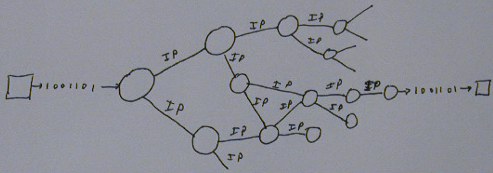 A message sent from any one device is automatically routed from IP device to IP device until it gets to its destination. The particular communications medium used between any specific pair of those devices is immaterial.
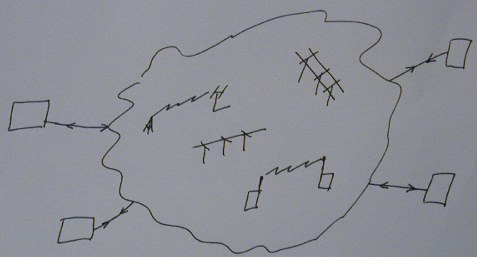 What matters is that the bits, the ones and zeros, make it from one end to another. All you need is a digital connection to one IP device that is connected to this "cloud" of devices, and then you can almost instantly send a message to any other device. All applications running on a digital device can share one connection device simultaneously with almost no switching cost. It takes almost the same amount of time to email one person as a thousand. All applications can use any communications infrastructure. Creating a new application now requires even less capital or use of scarce resources, leading to fewer natural monopolies and less regulatory control. Distance doesn't matter as much either. The step-by-step nature of the Internet hides all that.
Improvements to the communications infrastructure can be made independent of the use. As the "cloud" gets bigger and transmits data faster, all applications can benefit without expensive reimplementation.
Now, what do I mean by a "digital device"?
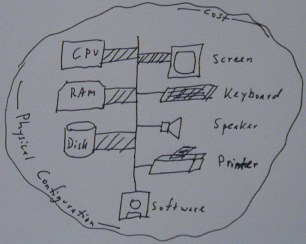 Well, they have computing components, like central processing units, a CPU, working memory, RAM, and perhaps storage that persists when you turn it off, like a hard disk. They have input and output devices to connect them to the outside world, like screens, keyboards, and speakers. These components are all tightly connected together. The devices have software programs that control the interaction of these connected components. Finally, the whole thing is packaged some way and manufactured for a particular price. The differing combinations of computing components, input/output devices, software, physical configuration and cost give us a taxonomy for comparing one digital device to another.
For example, let's look at the difference between the old mainframes and the early personal computers. Here's a diagram showing a mainframe with a big CPU and RAM, big disk, and lots of terminals.
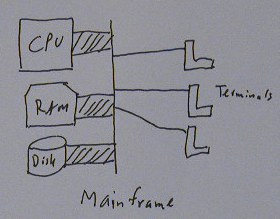 The CPU is very tightly connected to the disk by high speed connections. What is this good for? Well, calculations with lots of data, payroll, airline reservations, like being General Motors and asking the question "How many employees doubled their salary in the last year with a surname ending in 'X'?". A simple question going down the line from a terminal. Lots of data moving between the CPU and disk. Hopefully a short answer.
[Continue with Draft #1a (cont.)]
|
|
|
© Copyright 2000 by Daniel Bricklin
All Rights Reserved.
|